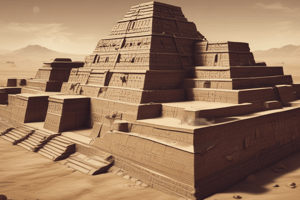Podcast
Questions and Answers
What was the most famous invention of the Sumerians?
What was the most famous invention of the Sumerians?
- Bronze
- Wagon wheel
- Cuneiform writing (correct)
- Sundial
The Sumerians primarily relied on hunting for their economy.
The Sumerians primarily relied on hunting for their economy.
False (B)
What were the main materials imported by Sumerian traders?
What were the main materials imported by Sumerian traders?
Copper and tin
The _____ was known as the wedge-shaped writing system of the Sumerians.
The _____ was known as the wedge-shaped writing system of the Sumerians.
Match the following Egyptian regions with their descriptions:
Match the following Egyptian regions with their descriptions:
Which of the following inventions did the Sumerians NOT contribute?
Which of the following inventions did the Sumerians NOT contribute?
The Nile River is recognized as the second longest river in the world.
The Nile River is recognized as the second longest river in the world.
Why was the yearly flooding of the Nile River referred to as a 'miracle'?
Why was the yearly flooding of the Nile River referred to as a 'miracle'?
What were two key factors that encouraged people to settle in Mesopotamia?
What were two key factors that encouraged people to settle in Mesopotamia?
Mesopotamia is located between the Nile and Amazon Rivers.
Mesopotamia is located between the Nile and Amazon Rivers.
What is a city-state?
What is a city-state?
The primary religion in Mesopotamia was ________.
The primary religion in Mesopotamia was ________.
Match the following Sumerian city-states with their characteristics:
Match the following Sumerian city-states with their characteristics:
Which of the following correctly describes the government of Sumerian city-states?
Which of the following correctly describes the government of Sumerian city-states?
Sumerian civilization included only one social class.
Sumerian civilization included only one social class.
Name one major contribution of the Sumerians in architecture.
Name one major contribution of the Sumerians in architecture.
Which of the following barriers provided security from invaders in ancient Egypt?
Which of the following barriers provided security from invaders in ancient Egypt?
The Middle Kingdom is often referred to as the 'golden era' of ancient Egypt.
The Middle Kingdom is often referred to as the 'golden era' of ancient Egypt.
What title was given to the rulers of ancient Egypt during the Old Kingdom?
What title was given to the rulers of ancient Egypt during the Old Kingdom?
The first royal dynasty of Egypt was formed around _____ B.C.
The first royal dynasty of Egypt was formed around _____ B.C.
Match the following periods with their distinctive characteristics:
Match the following periods with their distinctive characteristics:
What major accomplishment was associated with the Middle Kingdom?
What major accomplishment was associated with the Middle Kingdom?
Pharaohs during the Old Kingdom were seen as leaders with limited power.
Pharaohs during the Old Kingdom were seen as leaders with limited power.
What was the practice of drying a dead body to prevent it from rotting called in ancient Egypt?
What was the practice of drying a dead body to prevent it from rotting called in ancient Egypt?
Flashcards
Mesopotamia
Mesopotamia
The land between the Tigris and Euphrates rivers known for fertile land, supporting agriculture and trade and the rise of early civilizations.
Mummification
Mummification
The process of drying and preserving bodies in ancient Egypt to prevent decomposition.
Cuneiform
Cuneiform
A complex system of writing developed in Mesopotamia using wedge-shaped marks on clay tablets.
Ziggurats
Ziggurats
Signup and view all the flashcards
Uruk
Uruk
Signup and view all the flashcards
King Menes
King Menes
Signup and view all the flashcards
Miracle of the Nile
Miracle of the Nile
Signup and view all the flashcards
Nile River
Nile River
Signup and view all the flashcards
Pharaohs
Pharaohs
Signup and view all the flashcards
Old Kingdom
Old Kingdom
Signup and view all the flashcards
Middle Kingdom
Middle Kingdom
Signup and view all the flashcards
Scribes
Scribes
Signup and view all the flashcards
Sumerian Society Structure
Sumerian Society Structure
Signup and view all the flashcards
Bronze
Bronze
Signup and view all the flashcards
Sumerian Trade
Sumerian Trade
Signup and view all the flashcards
Egyptian Economy
Egyptian Economy
Signup and view all the flashcards
Division of Time
Division of Time
Signup and view all the flashcards
Sundial
Sundial
Signup and view all the flashcards
Wagon Wheel
Wagon Wheel
Signup and view all the flashcards
Arch
Arch
Signup and view all the flashcards
Mesopotamian City-States
Mesopotamian City-States
Signup and view all the flashcards
Polytheism
Polytheism
Signup and view all the flashcards
Clay Tablets
Clay Tablets
Signup and view all the flashcards
Sumerian Economy
Sumerian Economy
Signup and view all the flashcards
Study Notes
Areas Suitable for Settlement
- Mesopotamia was an area between the Tigris and Euphrates rivers and was known as "the land between the rivers"
- Fertile land enabled the growth and development of civilization
- Agriculture and trade were vital to Mesopotamia's growth and development
City-States and Religion
- Sumerian civilization arose in Mesopotamia and consisted of city-states each with its own political and economic control
- Mesopotamian city-states had unique identities and ruled by their own kings
- Sumerian civilization included cities like Eridu, Ur, and Uruk, each surrounded by walls and defense towers
- Sumerians were known for building massive stepped pyramids called ziggurats, which functioned as temples
- The Sumerian religion was polytheistic, meaning they believed in and worshipped multiple gods
Egyptian Kingdoms
- The history of Egypt is divided into three major periods: The Old Kingdom, Middle Kingdom, and New Kingdom, each marked by long-term stability, strong leadership, and significant cultural achievements
- The Old Kingdom, lasting from 2700 B.C. to 2200 B.C., was an era of prosperity and splendor
- The Middle Kingdom, lasting from 2055 B.C. to 1650 B.C., is considered a “golden era” marked by expansion and significant achievements, including the conquest of Nubia and the establishment of trading routes
The Nile River
- The Nile River played a vital role in the development of Egyptian civilization, providing food and resources
- It is the longest river in the world, originating in central Africa and emptying into the Mediterranean Sea
- The Nile's annual flooding, a phenomenon known as the "miracle of the Nile", left behind rich fertile soil, allowing farmers to grow surplus crops
- The river facilitated travel and communication, connecting different parts of Egypt
- Natural barriers like deserts, the Red Sea, and rapids protected Egypt from invasion
- The Nile River was significant for agriculture, transportation, and trade fostering growth and prosperity
Egyptian Pharaohs
- The merging of Upper and Lower Egypt resulted in the creation of the first royal dynasty around 3100 B.C., led by King Menes
- Pharaohs were seen as divine rulers with absolute power, supported by their families
- They held complete control over the government and military and were responsible for overseeing the construction of massive projects like the pyramids
The Old Kingdom
- During the Old Kingdom, the government was organized into 42 provinces, each ruled by a governor appointed by the pharaoh
- Egyptians practiced mummification, a process of drying and preserving bodies, to prevent decomposition
Social Groups
- Sumerian society consisted of a complex hierarchy with three main groups: nobles, commoners, and slaves
- The nobles included priests, government officials, and wealthy families
- The commoners included merchants, farmers, and craftspeople
- Slaves were owned by palace officials
Sumerian Inventions
- The Mesopotamians were highly innovative and developed a system of writing called cuneiform.
- Cuneiform was used to keep records on clay tablets, which have been discovered by scholars
- Scribes played a crucial role in society, serving as teachers, jurists, and copyists, often holding positions of influence in their cities
- Other inventions included the wagon wheel, sundial, and arch, signifying their advanced technological achievements
- The Sumerians were the first to create bronze by mixing copper and tin
- They made significant contributions to math and astronomy, including the division of time into hours and minutes
The Sumerian Economy
- The Sumerian economy was centered around trade, farming, and industry
- They produced woolen textiles, pottery, and metalwork
- Sumerian traders traveled to the eastern Mediterranean and India, trading barley, dried fish, wheat, and other goods for imported copper and tin
The Egyptian Economy
- The Nile's annual flooding played a vital role in Egypt's economy and supported a thriving agricultural society
- The pharaoh's role in managing resources and promoting trade contributed to the success of the Egyptian economy
- The Egyptian economy was also supported by taxes, labor contributions, and trade with other civilizations
"Think About It" Questions
- Describe how the city-states in Mesopotamia operated, and explain the structure of their society
- Discuss the significance of the Sumerians' inventions, explaining why they are considered important milestones in human history
Studying That Suits You
Use AI to generate personalized quizzes and flashcards to suit your learning preferences.




